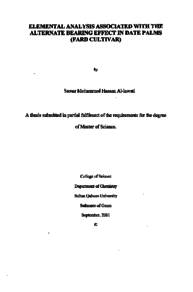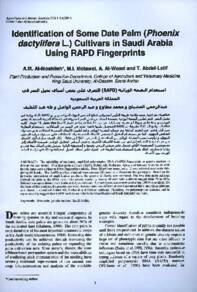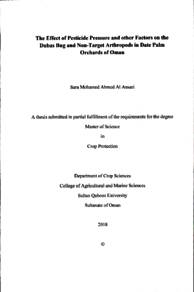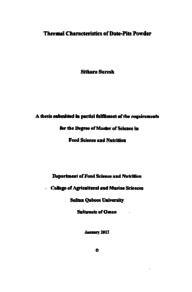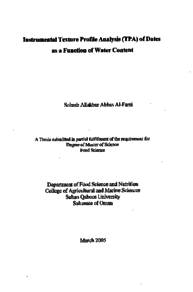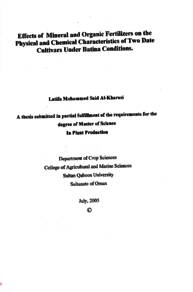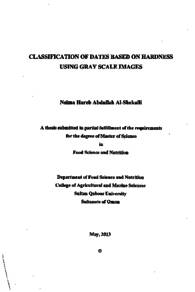Document
Elemental analysis associated with the alternate bearing effect in date palms (Fard cultivar).
Publisher
Sultan Qaboos University
Gregorian
2001
Language
English
English abstract
Samples of fruits, leaflets and soil from 6-"on" palms and 6 "off' palms of the Fard cultivar (15-16 years) were collected during the fruit developmental stages of Kimri, Bisir and Rutab. Specimens were dried, digested and subjected to general elemental analysis by ICP-AES. In particular, nitrogen was determined by the Kjeldahl method and phosphorus was evaluated by absorption spectrophotometry.
Significant changes in the elemental concentrations of leaf and fruit occurred between Kimri and Bisir where K and Mg concentrations decreased. Calcium and Na were reduced in the fruit and increased in the leaf. Iron, Zn and Mn were not significantly different between Bisir and Kimri. However, Cu in the fruit was reduced. The concentrations of Ca, Mg, Fe and Mn was higher in the leaf than fruit. In contrast K, Zn, and Cu were higher in the fruit. These variations in the leaf and fruit elemental concentrations were associated with physiological and biochemical changes during fruit development. No significant difference in the leaf and fruit elemental concentrations between the "on" and "off" palms was observed. The general trend during Rutab indicates that "off" palm leaves have higher N, Ca, Mg, Fe, Zn, Cu and Mn than "on" palm leaves and "offpalm fruits have higher P, K, Ca, Mg, Na, Fe, Zn and Mn than "on" palm fruits. Potassium, Zn, Cu were higher in the "off' palm fruits rather than in leaves. Other tested elements in fruit followed the same trend as the leaf. The "on" palm accumulated more dry matter than the "off" palm in leaf (14.86%, 10.50%) and in fruit (18.09%, 10.37%) respectively.
In addition to the above elemental changes, notable variations in boron concentration were observed in all the analysed samples and studied as a function of the phases of the fruit-bearing level. The B levels were typically between 100-300 ug/L in fruit and soil specimens, and 30-200 ug/L in leaves. It was discovered that an "off" palm could possibly be identified by lower levels of B in date leaves than for an "on" palm in the Bisir stage of development. In this connection, the experimental results revealed that the "on" trees produced B levels above about 140 ug/L, and the "off" palms could be characterized by B levels below this value. In addition, K/B and Ca/B ratios were evaluated as a possible guide to boron toxicity and deficiency. It was found that for normal growth, the magnitude of the K/B ratios for dates, in most cases, fell between 1000-2000, and for corresponding leaf specimens between 400-2000; and the Ca/B ratios, in most cases, occurred between 700-1500 for leaves, and between 150-300 for fruit. An interesting observation was that K/B ratios in excess of 2500 were found only in the "off" palms for the leaves in the Kimri stage.
Another aspect of the study involved the monitoring of trace metal accumulation (Al, Cr and Ba) in date palms. The results for all three elements showed some evidence of metal accumulation. Intermittent dramatic increases in concentration were observed for the leaf and fruit samples from both the batches of "on" and "off' palms. In the case of Al, the levels ranged between <1-5480 ug/L for the fruit, but there was no evidence of Al accumulation in the leaves. For Cr, the concentrations were in the range <1-1640 ug/L for the fruit and <1-720 ug/L for the leaves. For Ba, the levels ranged between <1-840 ug/L for the fruit and <1-440 ug/L for the leaves. The experimentally observed data demonstrated that there is decidedly an accumulation of the metals of interest in the plant material. The levels of accumulation were, generally, above the typical values expected for these elements, but the average concentrations fell within acceptable limits.
The study formed an interesting contribution to research associated with date palms and some recommendations for future work are included.
Member of
Resource URL
Arabic abstract
جمعت عينات من السعف والثمار والتربة من 6 نخلات من صنف الفرض (۱۵-۹ اسنة) حملها غزير وآخر حملها خفيف خلال مراحل تطور الثمار من الكمري إلى البسر ثم الرطب، ومن ثم جففت و هضمت وتم تحليل المعادن المغذية بواسطة ال( ICP - AES ) ما عدا النيتروجين فقد قيس بواسطة كلدال، والفسفور بطريقة الإسبكتروفوتومتر. ظهرت تغيرات بفروقات معنوية في تراكيز المعادن في السعف والثمار بين مرحلتي الكمري والبسر، تناقص ال K و Mg في السعف. لم تكن هناك فروقات معنوية في تراكيز ال Fe و Zn و Mn ولكن ال Cu تناقص في الثمار بين المرحلتين. كانت تراكيز Ca و Mg وFe وMn أعلى في السعف عما هو عليه في الثمار، بينما كان ال K وZn وCu أعلى في الثمار عن السعف. وقد تزامنت هذه التغيرات في التراكيز مع تغيرات فسيولوجية وكيميائية خلال مراحل تطور الثمار، لم تلاحظ فروقات معنوية في تراكيز المعادن المغذية في النخلات خفيفة الحمل وتلك غزيرة الحمل. ولكن الاتجاه العام يميلfi الى احتواء سعاف النخلات خفيفة الحمل على تراكيز أعلى من ال N وCa و Mg و Zn , Fe وCu و Mn عن النخلات غزيرة الحمل. كذلك تلاحظ أن ثمار النخلات خفيفة الحمل تحتوي على تراكيز أعلى من ال P و Gas K وZn وFe وNa و Mg و Mn عن النخلات غزيرة الحمل. ولكن ال K وNa وCu كانت أعلى في ثمار النخلات خفيفة الحمل عما هي عليه في السعف. أما باقي المعادن في الثمار فقد جاءت نتائجها مثل ما هي عليه في السعف. لقد كان تراكم المادة الجافة في سعف النخلات غزيرة الحمل أعلى من ما هو عليه في سعف النخلات خفيفة الحمل ( % ۱۰ , ۸۹ و ۱۰ , ۰۰ %) وفي الثمار كذلك كان (۱۸٫۰۹% و ۱۰٫۳۷%) على التوالي. بالإضافة إلى ما سبق أظهرت النتائج اختلافات ملحوظة في تراكيز ال B في التربة والسعف والثمار حسب درجة الحمل. تراوح تراكيز ال B بین ۱۰۰-۳۰۰ ميكروغرام / لتر في الثمار و التربة و ۳۰-۲۰۰ / لتر في السعف. أظهرت النتائج أيضا امكانية التعرف على النخلات خفيفة الحمل بواسطة احتواء سعافها على تراكيز أقل من أل B عن سعاف النخلات غزيرة الحمل أثناء مرحلة البسر. بناء عليه يمكن تصنيف النخلات التي تحتوي س عافها علی تركيز اعلى من 140 جزء في البليون بأنها غزيرة الحمل، وما دون ذلك بأنها خفيفة الحمل. كذلك تمت دراسة امكانية استخدام نسبة ال Ca / B , KB كمؤشر الى نقص أو تنمية البورون، واتضح من ذلك أنه في غالبية الحالات يكون نمو النخلات طبيعيا إذا تراوحت نسبة ال KB في الثمار بین ۱۰۰۰، ۲۰۰۰ على أن تكون بالمقابل م ن السعف بین ۸۰۰ و ۲۰۰۰، أما نسبة Ca / B في الغالب تكون بین ۷۰۰ و ۱۵۰۰ في السعف وبين ۱۰۰ و ۳۰۰ في الثمار. لقد تلاحظ أن نسبة KB أعلى من ۲۵۰۰ وجدت في أوراق النخلات خفيفة الحمل في مرحلة الكمري. وفي جانب أخر من هذا البحث تمت مراقبة تراكمات المعادن الثقيلة Al وCr وBa أوضحت النتائج وجود تراکم لهذه المعادن. كانت هناك زيادات متقطعة في تراكيزها في السعف والثمار في حالتي الحمل الخفيف والغزير. تراوح تركيز ال Al بین ۷۱ و 54۸۰ ميكروغرام/ لتر في الثمار بينما لم يكن هناك تراكم في السعف. تراوحت تراكيز ال Cr بين 1 و1640 ميكروغرام/لتر في الثمار وبين ۷۱ و ۷۲۰ ميكروغرام التر في السعف. تراوح تراكيز ال Ba بين 1 و ۸۰۰ ميكروغرام / لتر في الثمار وبين 1 و440 ميكروغرام/لتر في السعف. يتضح من ذلك أن هناك تراكم لهذه المعادن في الثمار والسعف وقد كانت مرتفعة كما هو متوقع ولكنها في المتوسط تقع في الحدود المقبولة. لقد شكلت هذه الدراسة إضافة حقيقية في مجال بحوث نخلة التمر وتضمنت الدراسة بعض التوصيات للعمل في المستقبل.
Category
Theses and Dissertations

